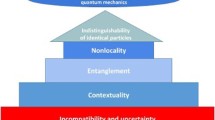Abstract
The paper constructs modal structures that represent alternative developments of GRW systems. With these modal structures in hand, it shows that GRW probabilities can be read as graded modalities, that is, as numerically specified powers of a system to localize. The construction is intended as offering support for Dorato and Esfeld’s (Stud Hist Philos Mod Phys 41(1):41–49, 2010) project of conceiving GRW theory as an ontology of powers.
Access this chapter
Tax calculation will be finalised at checkout
Purchases are for personal use only
Similar content being viewed by others
Notes
- 1.
Another illustration of this tendency is the debate over probabilities in the consistent histories quantum mechanics; for an argument that these probabilities can be read as single case causal probabilities – see Müller (2007).
- 2.
See for instance Ghirardi et al. (1986).
- 3.
As GRW theory does not posit particles, “N-particles system” is a misnomer. If the theory is supplemented with a flash ontology, the phrase means that flashes come in kinds, and the system in question involves exactly N kinds of flashes.
- 4.
For more on the conceptual issues arising from combining GRW theory and relativity, see Maudlin (2008).
- 5.
By trivial case I mean here a case with \(\Pi _{e}\) having one element only.
- 6.
See Sylvia Wenmackers’s work, http://www.sylviawenmackers.be
- 7.
For a proof that \(\Pi _{e}\langle \mathbf{O}\rangle\) exists and is unique, see Belnap (2003).
- 8.
For the postulates see, for instance Belnap (2003).
References
Allori, V., S. Goldstein, R. Tumulka, and N. Zanghì, 2008. On the common structure of Bohmian mechanics and the Ghirardi-Rimini-Weber theory. The British Journal for the Philosophy of Science 59(3): 353–389.
Bell, J. 1987. Are there quantum jumps? In Schrödinger. Centenary of a polymath. Cambridge: Cambridge University Press. Reprinted In Bell, J.S. 1987. Speakable and unspeakable in quantum mechanics. Cambridge: Cambridge University Press.
Belnap, N. 2003. No-common-cause EPR-like funny business in branching space-times. Philosophical Studies 114: 199–221.
Belnap, N. 2005. A theory of causation: Causae causantes (originating causes) as inus conditions in branching space-times. The British Journal for the Philosophy of Science 56: 221–253.
Dorato, M., and M. Esfeld. 2010. GRW as an ontology of dispositions. Studies in History and Philosophy of Modern Physics 41(1): 41–49.
Frigg, R., and C. Hoefer. 2007. Probability in GRW theory. Studies in History and Philosophy of Modern Physics 38: 371–389.
Ghirardi, X., Y. Rimini, and Z. Weber. 1986. Unified dynamics for microscopic and macroscopic systems. Physical Review D 34: 470–491.
Maudlin, T. 2008. Non-local correlations in quantum theory: How the trick might be done. In Einstein, relativity and absolute simultaneity, ed. W.L. Craig and Q. Smith. London/New York: Routledge.
Müller, T. 2005. Probability theory and causation: A branching space-times analysis. The British Journal for the Philosophy of Science 56(3): 487–520.
Müller, T. 2007. Branch dependence in the ‘consistent histories’ approach to quantum mechanics. Foundations of Physics 37(2): 253–276.
Müller, T. 2011. Probabilities in branching structures. In Explanation, prediction and confirmation, ed. D. Dieks, W.J. Gonzalez, S. Hartmann, T. Uebel, and M. Weber, 109–121. Berlin: Springer.
Placek, T., and N. Belnap. 2012. Indeterminism is a modal notion: Branching spacetimes and Earman’s pruning. Synthese 187(2): 441–469. doi:10.1007/s11229-010-9846-8.
Tumulka, R. 2006. A relativistic version of the Ghirardi-Rimini-Weber model. Journal of Statistical Physics 125(4): 825–844.
Wroński, L., and T. Placek. 2009. On Minkowskian branching structures. Studies in History and Philosophy of Modern Physics 40: 251–258.
Author information
Authors and Affiliations
Corresponding author
Editor information
Editors and Affiliations
Rights and permissions
Copyright information
© 2014 Springer International Publishing Switzerland
About this chapter
Cite this chapter
Placek, T. (2014). Causal Probabilities in GRW Quantum Mechanics. In: Galavotti, M., Dieks, D., Gonzalez, W., Hartmann, S., Uebel, T., Weber, M. (eds) New Directions in the Philosophy of Science. The Philosophy of Science in a European Perspective, vol 5. Springer, Cham. https://doi.org/10.1007/978-3-319-04382-1_40
Download citation
DOI: https://doi.org/10.1007/978-3-319-04382-1_40
Published:
Publisher Name: Springer, Cham
Print ISBN: 978-3-319-04381-4
Online ISBN: 978-3-319-04382-1
eBook Packages: Humanities, Social Sciences and LawPhilosophy and Religion (R0)




